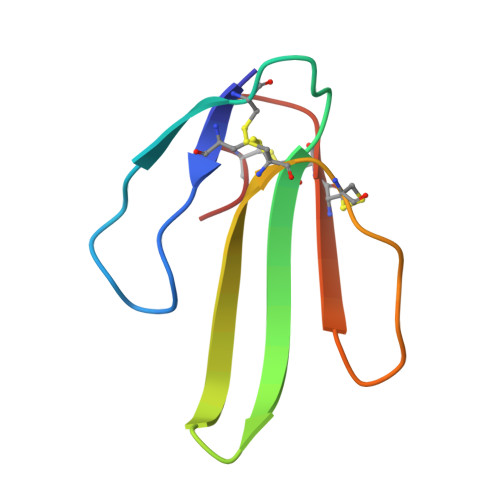Motions and structural variability within toxins: Implication for their use as scaffolds for protein engineering
Gilquin, B., Bourgoin, M., Menez, R., Le Du, M.H., Servent, D., Zinn-Justin, S., Menez, A.(2003) Protein Sci 12: 266-277
- PubMed: 12538890
- DOI: https://doi.org/10.1110/ps.0227703
- Primary Citation of Related Structures:
1IQ9 - PubMed Abstract:
Animal toxins are small proteins built on the basis of a few disulfide bonded frameworks. Because of their high variability in sequence and biologic function, these proteins are now used as templates for protein engineering. Here we report the extensive characterization of the structure and dynamics of two toxin folds, the "three-finger" fold and the short alpha/beta scorpion fold found in snake and scorpion venoms, respectively. These two folds have a very different architecture; the short alpha/beta scorpion fold is highly compact, whereas the "three-finger" fold is a beta structure presenting large flexible loops. First, the crystal structure of the snake toxin alpha was solved at 1.8-A resolution. Then, long molecular dynamics simulations (10 ns) in water boxes of the snake toxin alpha and the scorpion charybdotoxin were performed, starting either from the crystal or the solution structure. For both proteins, the crystal structure is stabilized by more hydrogen bonds than the solution structure, and the trajectory starting from the X-ray structure is more stable than the trajectory started from the NMR structure. The trajectories started from the X-ray structure are in agreement with the experimental NMR and X-ray data about the protein dynamics. Both proteins exhibit fast motions with an amplitude correlated to their secondary structure. In contrast, slower motions are essentially only observed in toxin alpha. The regions submitted to rare motions during the simulations are those that exhibit millisecond time-scale motions. Lastly, the structural variations within each fold family are described. The localization and the amplitude of these variations suggest that the regions presenting large-scale motions should be those tolerant to large insertions or deletions.
Organizational Affiliation:
Département d'Ingénierie et d'Etude des Protéines, CEA, 91191 Gif sur Yvette, France. bgilquin@cea.fr















